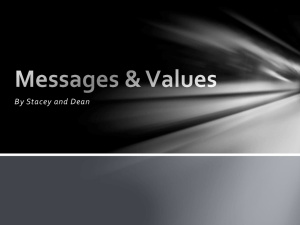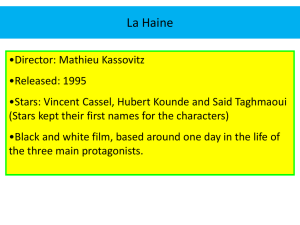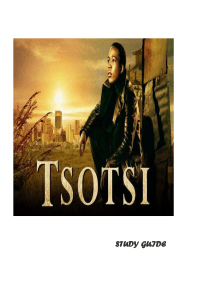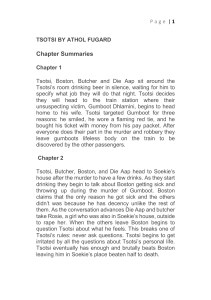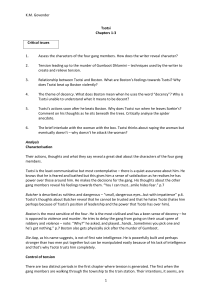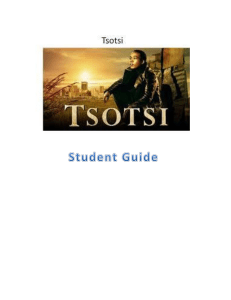Year 13 English through Film - Literacy-English-ESOL
advertisement
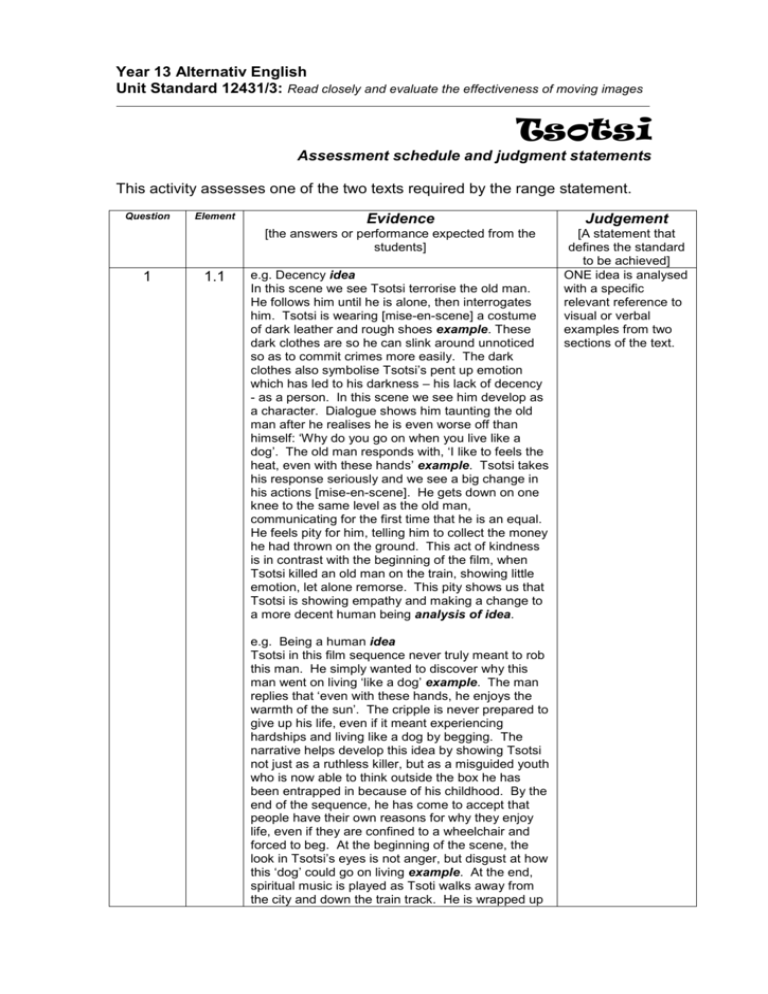
Year 13 Alternativ English Unit Standard 12431/3: Read closely and evaluate the effectiveness of moving images Tsotsi Assessment schedule and judgment statements This activity assesses one of the two texts required by the range statement. Question 1 Element 1.1 Evidence Judgement [the answers or performance expected from the students] [A statement that defines the standard to be achieved] ONE idea is analysed with a specific relevant reference to visual or verbal examples from two sections of the text. e.g. Decency idea In this scene we see Tsotsi terrorise the old man. He follows him until he is alone, then interrogates him. Tsotsi is wearing [mise-en-scene] a costume of dark leather and rough shoes example. These dark clothes are so he can slink around unnoticed so as to commit crimes more easily. The dark clothes also symbolise Tsotsi’s pent up emotion which has led to his darkness – his lack of decency - as a person. In this scene we see him develop as a character. Dialogue shows him taunting the old man after he realises he is even worse off than himself: ‘Why do you go on when you live like a dog’. The old man responds with, ‘I like to feels the heat, even with these hands’ example. Tsotsi takes his response seriously and we see a big change in his actions [mise-en-scene]. He gets down on one knee to the same level as the old man, communicating for the first time that he is an equal. He feels pity for him, telling him to collect the money he had thrown on the ground. This act of kindness is in contrast with the beginning of the film, when Tsotsi killed an old man on the train, showing little emotion, let alone remorse. This pity shows us that Tsotsi is showing empathy and making a change to a more decent human being analysis of idea. e.g. Being a human idea Tsotsi in this film sequence never truly meant to rob this man. He simply wanted to discover why this man went on living ‘like a dog’ example. The man replies that ‘even with these hands, he enjoys the warmth of the sun’. The cripple is never prepared to give up his life, even if it meant experiencing hardships and living like a dog by begging. The narrative helps develop this idea by showing Tsotsi not just as a ruthless killer, but as a misguided youth who is now able to think outside the box he has been entrapped in because of his childhood. By the end of the sequence, he has come to accept that people have their own reasons for why they enjoy life, even if they are confined to a wheelchair and forced to beg. At the beginning of the scene, the look in Tsotsi’s eyes is not anger, but disgust at how this ‘dog’ could go on living example. At the end, spiritual music is played as Tsoti walks away from the city and down the train track. He is wrapped up in his own world pondering what it is to be human. Once he had spoken to the old cripple. He realised that the man was human as deserved to be treated with respect and dignity analysis of idea. 2 and 3 1.2 e.g. The impact of circumstances on who you are idea The impact of circumstances greatly affects who you are. We see this with Tsotsi’s friends, who stand out in the crowd of people who are bustling about. They, on the other hand, simply stand there waiting for Tsotsi to arrive at the station. The circumstances Tsotsi has grown up in have made him an angry person, just as the circumstances the crippled man has been forced to live in after his mining accident have made him an angry person. This is seen in the aggressive dialogue, ‘Where did you get that license? Your mum teach you to drive?’ and ‘Watch where you are going, dog!’ example Tsotsi’s anger is portrayed when he sets out to get revenge on the cripple, who has offended him by cursing at him and calling him a dog. Any normal person would have left the cripple alone, but Tsotsi’s upbringing [the lack of love and need to survive through violence] has meant that he reacts negatively to him, threatening him with violence example. Towards the end of the film, Tsotsi is delivered from crime through the experience he has with the baby he kidnaps. He is no longer angry and is more respectful as a result. Being brought up in the poor conditions he has left Tsotsi with the need to be tough and commit crime to survive analysis of idea. e.g. physical context The fact that the old man has been crippled has left him an angry man, most probably because he has been treated differently idea. His physical disability means he doesn’t get the respect he would have received if he could walk. His survival is determined by his ability to stand up for himself, and this is done through aggression analysis of idea. Evidence of him being angry is when he first addressed Tsotsi: ‘Watch where you are going, dog!’ example and when he spits on Tsotsi example. Another example of this aggression is when he curses the driver of a car that nearly knocks him over. He is aggressive because this is not the first time it has happened. e.g. social context The old beggar hangs around Johannesburg station. He is aware to the trouble that goes on in South Africa. He is black and crippled and has experienced a lot in his life idea. We see this where, after Tsotsi walks over, he says, ‘Hey, look where you are fucking going!’ example This shows that life as a crippled black man is harsh and has made him the aggressive man he is today analysis of idea. We also see this when he automatically thinks Tsotsi is there to mug him: ‘Do you want my money?’ example This shows that he expects this to happen, which shows how difficult life is for poor blacks in South Africa analysis of idea. Significance of ONE idea is critically evaluated and supported by reference to TWO relevant sections of the text. 4 1.3 e.g. historical context The old man would have lived through Apartheid and was exploited as cheap labour, working in the mines where he would have almost never seen the sun. When his back was broken in a mining accident, he was unable to work again, but could feel the sun on his skin, which for him was a mixed blessing idea. An example of the historical context impacting on the man is the [prop] of the wheelchair, which is home-made and makeshift example. Anther example is the fact he has been forced to beg for survival example. These examples tell us he has little support as a cripple, as he has had to make it himself. We learn that the South African government has not helped him, even though it was a workplace accident analysis of idea. e.g. lighting [visual] At the end, as Tsotsi walks away, the old man’s head is bathed in light example. The effect of the technique is spiritual. The old man’s life has been saved and in the process, he has helped Tsotsi redeem himself effect. The technique is effective. The shot is till and the light illuminates the old man, giving a spiritual aspect to him and communicating that good can come out of bad situations critical evaluation of effect. e.g mid-shot [visual] A mid-shot of Tsotsi holding his gun and trash-can lid as he guards against the rocks being thrown at him. The old man weeps and asks if he is happy he has made an old man ‘piss his pants’ example. The effect of the technique is to show that Tsotsi is human with human emotions. He shows remorse or embarrassment at the fact he has had this effect on the old man effect. This is effective as it shows he is developing as a character and being to show empathy for the first time critical evaluation of effect. e.g music [verbal] When the old man is swearing at Tsotsi, the music is dark and foreboding and it builds to a crescendo as Tsotsi pulls out his gun example. The effect of the technique is to heighten the mood of the scene and sow tension between the two characters effect. The technique is effective because it builds to a crescendo which changes the mood of the scene from hostile to fearful. Tsotsi now has control critical evaluation of effect. e.g. music [verbal] After Tsotsi’s encounter with the old man, he walks along the railway and the background music is calm, gentle and remorseful example. The director’s purpose to show Tsotsi changing and feeling guilty about his actions effect. It is effective because it contrasts with the beginning where Tsotsi was with his friends and lacking in remorse for his actions. This time, he didn’t kill, which shows change and development as a character critical evaluation of effect. THREE examples of language features are accurately identified using appropriate terminology. The effect of each example is critically evaluated in terms of its contribution to a range of thematic ideas or character development. Note: ONE verbal feature and ONE visual feature must be included in the examples. 5 a) and b) 1.4 e.g. A long shot of Tsotsi walking up the train tracks with the city behind him is combined with hopeful, calm, traditional South African music [relationship between visual and verbal feature]. The effect of them being used together is to show Tsotsi is taking his first steps towards becoming a better person. The combination of these techniques is effective because the shot of Tsotsi walking away from the city symbolises Tsotsi walking away from the trouble he has caused, as he would always go into the city to commit the crimes. The music provides hope and gives the viewer a sense that Tsotsi has learned a valuable lesson from the old man and has now made a small turn for the better [critical evaluation of the effect]. TWO examples of the relationship between a visual and a verbal feature are critically evaluated in terms of the effect each creates. e.g. A close up of Tsotsi after he has been spat on by the old man is combined with the sound effects of a rattling sound – like a rattle snake [relationship between visual and verbal feature]. The effect of them being used together is to give the audience a sense of how Tsotsi is disgusted and angered and that his reaction will be dangerous for the old man. The combination of these techniques is effective because it creates tension, as the audience is unsure whether Tsotsi is going to lash out at the man or not. It creates a small fear for the audience and reinforces that Tsotsi is dangerous [critical evaluation of the effect]. e.g. An establishing shot of the train station, with a banner warning about AIDS and people walking in different directions is combined with the dialogue of many different voices and someone speaking over the microphone announcing arrivals and departures [relationship between visual and verbal feature]. The effect of the, being used together is to give the sense of a big, industrial and busy space. The combination of these techniques is effective because it shows that the station is a place of employment and less poverty and it contrasts with the beginning, where everyone is hanging around and doing nothing. It reinforces the economic gulf between people in South Africa [critical evaluation of the effect]. 6 a) and/or b) and/or c) 1.5 e.g. Technique #1: contrast in characterisation In the exposition of the film, Tsotsi and his gang of thugs are out in Johannesburg trying to find someone to mug. They choose an old black man, mug, and murder him in the train. In ‘Egoli, City of Gold’, Tsotsi is alone with the old man. He looks like he is about to mug and perhaps murder him, but in the end, lets him go [example]. In the exposition, Tsotsi’s only motive was to get something from the man he mugs, but in the second scene, he is interested in finding out why the old man lives like he does. This contrast shows that Tsotsi is moving TWO techniques used to shape the texts are identified and critically evaluated with reference to TWO sections of the text. towards redemption as he is becoming more aware of how others may feel and the impact of his actions. He no longer wants to simply destroy, but want to empathise with others [critical evaluation of the effect]. e.g. Technique #2: contrast in sound In ‘Egoli, City of Gold’, Tsotsi speaks to the old man first, and with malice. The music is dark, with drum beats and rattling, creating tension. At the end of the film, Tsotsi only speaks once, and it is into the intercom a quiet and respectful tone. The music is uplifting, traditional music to show Tsotsi’s redemption [example]. This contrast communicates that Tsotsi is no longer aggressively in charge. He has changed the way he verbally [and physically] interacts with others. The music at the end communicates that Tsotsi has faced his inner demons and is ready to pay the price for his actions. The contrast is effective as it clearly displays Tsotsi’s changing mood from aggressive and dangerous to empathic and trying to do the right thing for others [critical evaluation of the effect]. e.g. Technique #3: contrast in setting In Egoli, City of Gold’, the train station is crowded, with people merging through each other. Aap and Butcher find it difficult to spot Tsotsi. In the exposition, Tsotsi’s house is cramped and makeshift, made of tin and recycled materials and furniture. This contrast communicates the inequity of the spread of resources in South Africa – Soweto is poor and lacks resources, while Johannesburg has more infrastructure. It is effective, as it shows one of the reasons why Tsotsi does what he does. He needs to scrounge off the wealthy to survive the poverty. It gives the viewer a greater understanding of the circumstances he lives in [critical evaluation of the effect].
